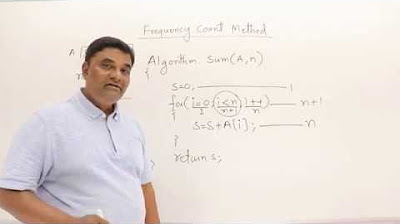Basics of Asymptotic Analysis (Part 3)
Summary
TLDRThis lecture delves into the concept of asymptotic complexity in algorithm analysis, emphasizing that exact running time calculations are impractical and less insightful. It illustrates how time complexity is inherently linked to input size, using an array example to demonstrate how shifting elements affects time. The focus is on the growth rate of time complexity functions, f(n), and how they can be compared for different data structures or algorithms. The script guides through the process of determining the dominant term in time complexity expressions, showcasing how higher-order terms become more significant as input size increases, ultimately explaining the use of asymptotic notation to approximate and simplify time complexity analysis.
Takeaways
- 😀 Asymptotic analysis is a better approach than measuring exact running time for calculating time complexity of algorithms.
- 🔍 Measuring the actual running time is impractical because it depends on the size of the input and is not constant.
- 📚 The running time of an algorithm is generally proportional to the size of the input, which is a key concept in understanding time complexity.
- 🔄 An example of shifting elements in an array illustrates how the time complexity increases linearly with the number of elements.
- 📈 The function f(n) represents the time complexity, indicating the number of instructions executed for an input of size n.
- 🔢 For simple programs, calculating f(n) is straightforward, but it becomes more complex as programs grow in size.
- 📊 Comparing the growth rate of f(n) between different data structures or algorithms is crucial for understanding their efficiency at larger input sizes.
- 📉 The percentage contribution of different terms in f(n) to the total running time can vary significantly with the input size.
- 📚 As n increases, higher-order terms (like n^2) dominate the running time, making lower-order terms and constants negligible.
- 🔎 Analyzing the growth rate helps identify which term in the time complexity function contributes the most to the running time for large inputs.
- 🚀 Asymptotic complexity focuses on the term that consumes the most time for large input sizes, simplifying the understanding of algorithm efficiency.
Q & A
Why is it not practical to measure the exact running time of an algorithm?
-Measuring the actual running time is not practical because it can vary significantly depending on the size of the input and the machine on which the algorithm is executed.
What is the main factor that affects the running time of an algorithm?
-The running time generally depends on the size of the input.
In the given example, how does the time complexity change with the size of the array?
-For an array of size 3, adding an element at the beginning requires 3 shifts, taking 3 units of time. For an array of size 10,000, it requires 10,000 shifts, taking 10,000 units of time.
What does the function f(n) represent in the context of time complexity?
-f(n) is a function that denotes the time complexity, representing the number of instructions executed for an input size n.
How does the time complexity function f(n) help in comparing data structures?
-By comparing the f(n) values of different data structures for various input sizes, we can determine which data structure performs better in terms of time complexity.
Why are we interested in the growth rate of f(n) rather than its exact value?
-We are interested in the growth rate of f(n) because it shows how the running time of an algorithm scales with the input size. This helps in understanding the algorithm's efficiency for large inputs.
What does the term 'asymptotic complexity' mean?
-Asymptotic complexity is the approximate measure of an algorithm's time complexity, focusing on the term that grows the fastest with the input size while ignoring smaller terms.
How does the growth rate of f(n) differ for the terms in the example f(n) = 5n² + 6n + 12 as n increases?
-For small values of n, the constant term (12) and the linear term (6n) may contribute significantly to the running time. However, as n increases, the quadratic term (5n²) dominates and contributes most of the time complexity.
Why is it acceptable to eliminate smaller terms in the time complexity function?
-It is acceptable to eliminate smaller terms because they contribute negligibly to the running time for large input sizes. The dominant term provides a sufficient approximation of the time complexity.
What is the key takeaway from understanding the growth rate of time complexity?
-The key takeaway is that the efficiency of an algorithm is best understood by focusing on how its running time grows with the input size, rather than exact running times, allowing for better comparison and selection of algorithms.
Outlines

This section is available to paid users only. Please upgrade to access this part.
Upgrade NowMindmap

This section is available to paid users only. Please upgrade to access this part.
Upgrade NowKeywords

This section is available to paid users only. Please upgrade to access this part.
Upgrade NowHighlights

This section is available to paid users only. Please upgrade to access this part.
Upgrade NowTranscripts

This section is available to paid users only. Please upgrade to access this part.
Upgrade NowBrowse More Related Video

Time Complexity | Big O Notation | Data Structures & Algorithms | JomaClass

Asymptotic Notations in Tamil | Data Structures and algorithm in Tamil | Unit 1 Abstract Data Types

L-1.3: Asymptotic Notations | Big O | Big Omega | Theta Notations | Most Imp Topic Of Algorithm

Understanding the Time Complexity of an Algorithm

Introduction to Algorithm Analysis

1.4 Frequency Count Method
5.0 / 5 (0 votes)